|
|
|
|
|
|
| Practical ecological knowledge for the temperate reader. |
Fawn Lily - Erythronium Sp.
Family: Liliaceae - Lily
Local Species;
- Erythronium grandiflorum- yellow glacier lily [E-flora][PCBC][TSFTK]
- Erythronium montanum - white glacier lily [E-flora][TSFTK]
- Erythronium oregonum - white fawn lily [E-flora][PCBC][TSFTK]
- Erythronium revolutum - pink fawn lily [E-flora][PCBC][TSFTK]
"Bulb elongate of 1–2 fleshy scales, generally with small, bead-like parts of persistent rhizome. Leaf: 2 (1 in non-flowering plant), basal, 6–35 cm, lanceolate to ovate (solitary basal leaf wider), narrowed to petiole, often mottled, glabrous; margin entire to wavy. Inflorescence: peduncled raceme; flowers 1–10; bracts 0. Flower: showy, generally nodding; perianth parts 6, similar, free, ± lanceolate, ± recurved; stamens 6; style 1, stigma entire to 3-lobed. Fruit: capsule, ovoid to oblong. Seed: ± ovoid, ± angular, brown.
n=12.
+/- 27 species: especially temperate North America. (Greek: red, from flowers of some) Leaf, flower markings to be noted when fresh, because of fading in pressed specimens." [Jepson]
Habitat/Range
E.montana; "Moist meadows and open forests in the montane and subalpine zones; rare on Vancouver Island and the adjacent mainland (Mt. Waddington area); S to N OR." [IFBC-E-flora-2]
Status: Native. Blue Listed [E-flora-2]
E. Grandiflorum; "Moist to mesic meadows, edges of snow-melt, along streams and occasionally in open forests in the montane to alpine zones; common throughout BC S of 53degreeN; E to AB and S to MT, UT and N CA." [IFBC-E-flora-1]
Status: Native [E-flora-1]
E.oregonum; "Dry to mesic meadows and open forests in the lowland zone; locally common on SE Vancouver Island, the Gulf Islands and the adjacent mainland; S to S OR." [IFBC-E-flora-1]
Status: Native [E-flora-3]
E. revolutum; "Moist forests and riverbanks in the lowland zone; locally frequent on Vancouver Island, rare on Valdez Island and on mainland at Kingcome Inlet; S to N CA." [IFBC-E-flora-4]
Status: Native [E-flora-4]
|
|
|
|
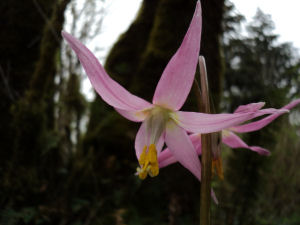
Erythronium revolutum |
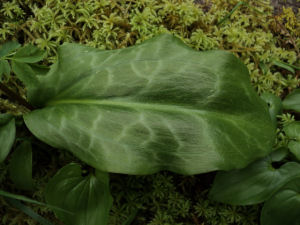
Erythronium revolutum |
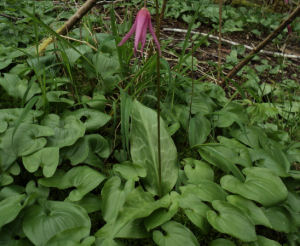
Erythronium revolutum |
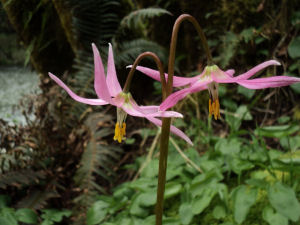
Erythronium revolutum |
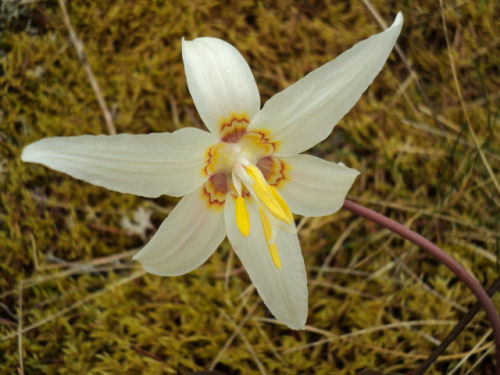
Erythronium oregonum |
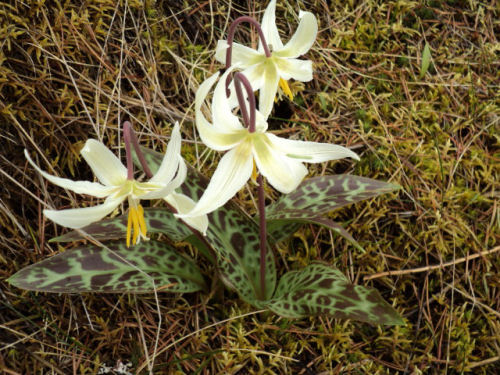
Erythronium oregonum |
Key to Erythronium
1) Lobes of stigma conspicuous, at least 1.5 mm long
- 5) Perianth bright yellow; leaves uniformly green (Brit. Coi. to Calif., mostly E of the crest of the Cascades, but occasionally found in the Coast Ranges, Wash. and Oreg.; plants in the Coast Ranges have pale, instead of dark reddish anthers, and have been referred to the var. pallidum) ... . . . . . . . . . . . . . . . . . . . . . . . . . . . . E. grandiflorum subsp. grandiflorum
Yellow Fawn Lily
- 5) Perianth, when fresh, predominantly white, cream, or light to dark pink
- 6) Perianth deep pink (white in extremely rare specimens; leaves, before and during the time of flowering, with conspicuous brownish mottling; coastal, Brit. Coi. to Calif.) . . . . . . . . . . E. revolutum
Pink Fawn Lily
- 6) Perianth white, cream, or pale pink (leaves usually with brownish markings, except in some E. elegans)
- 7) Filaments of stamens not becoming noticeably broader at the base than above (the width at the base is not more than 0.5 mm; perianth pure white with yellow or light orange at the base; in the Olympic Mountains, Wash., and in the Cascades of Wash. and Oreg.; not likely to be found below 4000 ft., 1220 m) . . . . . . . . . . . . . . . . . . . . . . . . . . . E. montanum
Avalanche Lily
- 7) Filaments of stamens distinctly broader (usually more than 0.5 mm) near the base than above
- 8) Perianth white to cream, usually with yellow and sometimes also with reddish markings at the base; leaves, before and during the time of flowering, with conspicuous brownish markings (widespread lowland species W of the Cascades, Brit. Coi. to S Oreg., possibly Calif.; usually flowering by early April) ........................... E. oregonum [????]
Oregon Fawn Lily
"In plants of E. oregonum on S Vancouver Island, Gulf Islands, Brit. Col., and San Juan
Islands, Wash., the perianth is usually almost completely pure white except for rather
prominent reddish markings at the base." [????]
Ecological Indicator
-
E.oregonum; "A shade-intolerant, submontane to montane, Pacific North American forb. Occurs in maritime to submaritime summer-dry cool mesothermal climates on moderately dry to fresh. nitrogen-medium soils.Common in meadowlike communities and open-canopy forests on water-shedding sites. Its occurrence decreases with increasing elevation and continentality. Characteristic of dry mesothermal forests." [IFBC-E-flora-3]
- E.revolutum; "A shade-tolerant/intolerant, submontane to montane. Pacific North American forb. Occurs in maritime to submaritime summer-wet cool mesothermal climates on fresh to moist, nitrogen-rich soils (Moder and Mull humus forms). Sporadic in broad-leaved forests on waterreceiving sites; its occurrence decreases with increasing latitude, elevation, and continentality. Characteristic of alluvial floodplain forests." [IPBC-E-flora]
Species Mentioned; Erythronium species - Dogs Tooth Violet [Tozer UWP]
Hazards
- E-montanum,E.oregonum,E.revolutum; "Although no records of toxicity have been seen for this species, the following notes have been seen for another member of this genus and so some caution is advised. Skin contact with the bulbs has been known to cause dermatitis in sensitive people[65]." [PFAF]
E. oregonum was reported by Kingsbury to have apparently caused poisoning to poultry. [Harrington]
- E. oregonum; "The bulbs have been suspected of poisoning poultry[256]. The following notes have also been seen for another member of this genus - skin contact with the bulbs has been known to cause dermatitis in sensitive people[65]." [PFAF]
Edible Uses
Bulb:
- These lovely little plants produce tasty edible roots, but are too pretty for casual use as food. especially as they are slow growing, and may take seven years to produce their first flowers. They are also hard to gather, as the tops break off if you pull on them, you must dig carefully. They are sometimes abundant however, in which case digging a few roots would do no hann. They are good raw in salads, or cooked like Camas (Camassia) bulbs. They were quite important to a number of Native American tribes, and were dried in large quantities for winter use. [Tozer UWP]
Erythronium spp. (glacier lily, avalanche lily, fawn lily); Liliaceae—bulb-forming perennial of open woods and meadows, N
America, E Asia; bulbs of various spp. cooked and eaten in Japan, Korea, NW N America.[ETWP]
- "The bulbs of pink fawn lily, or pink Easter lily (Erythronium
revolutum) were eaten by the Kwakwaka'wakw of Vancouver Island, and possibly some northern
Nuu-chah-nulth groups. Boas (1921) describes their use in detail. They were dug with special
spades when the leaves first sprouted in the spring, and stored in openwork baskets. Some times
they were eaten raw on a hot day; otherwise they were steamed in tall wooden boxes and served
with ooligan grease. They could also be baked for a short time in hot ashes and eaten with the
fingers; water was drunk afterwards. For storage, the bulbs were dried in the sun (Boas, 1921;
Turner, 1975). The related white fawn lily, or white Easter Lily (E.oreganum) of British Columbia is
not known to have been eaten, and has a reputation for toxicity (Kingsbury, 1964). The Micmac
were said to have eaten the "bulbs" of dogtooth violet, presumably E. americanum.They dug them in
spring and ate them raw, boiled, or baked in the hot ashes of a fire (Stoddard, 1962). Jack (1893)
noted that the Abenakis of Saint John River ate the roots of a "yellow lily," possibly also this species,
which they called Indian rice."[Turner&Kuhnlein]
- E-montanum;
- "raw, cooked or dried for later use[207]. An important food for the indigenous N. American Indians[207]. The narrowly ovoid bulbs are up to 6cm long[270]." [PFAF]
- E. oregonum;
- "Raw, cooked or dried for later use[183, 257]. The bulb is from 25 - 60mm long[270]. Some caution should be employed, see the notes above on toxicity[256]." [PFAF]
- "Erythronium bulbs were an important
food for the Kwakiutl (Boas, 1921). They
were eaten raw, baked, boiled, or dried.
They are abundant in the Salish area of
Vancouver Island, but their use is not specifically mentioned in the literature. Harry
(1969) stated that they were common only
after the coming of the white man."[Turner&Bell]
- E.revolutum;
- "Bulb - raw or cooked[256]. It can also be dried and stored for later use[257]. The bulbs are usually harvested in the spring as the first leaves appear above ground, they can be stored for some months in a cool place[256]. The raw bulb has a slightly bitter milky taste, the texture is cool and moist inside and so the North American Indians liked eating them on hot days[256]. The cooked bulb has a more starchy texture. The Indians always drank water after eating the bulbs because they believed that otherwise they would get sick[256]. The ovoid bulb is 35 - 50mm long[270]."[PFAF]
- "Erythronium bulbs were at one time a
valuable food of the Kwakiutl (King,
1972; Brown, 1969; Cranmer, 1969).
They were thought to grow only on river
banks. They were dug with special yew
wood spades when the leaves first sprouted in the spring. If they were kept in
ventilated baskets in a cool place, they
would keep for a long time. Some people
liked to eat them raw on a hot day,
because they were cool inside. They had a
slightly bitter milky taste. Otherwise they
could be cooked by several methods.
They were sometimes put in a flatbottomed basket and placed in a steaming
box with boiling water until they were
soft, then eaten with spoons. Large quantities of oulachen grease were eaten with
the bulbs because they were bitter. They
were prepared in this way for large feasts
given to many tribes. Another way to
prepare them for a feast was to dry them
in the sun, put them into boiling water
until they broke into pieces, and then mix
them with grease. For a simple family
meal, they were baked for a short time in hot ashes and dipped in grease with the
fingers. Water was always taken after eating lily bulbs, otherwise one would get
sick (Boas, 1921)."[Turner&Bell]
Medicinal Uses
Poultice: The roots have been used as a poultice for skin diseases. [Tozer UWP] E. oregonum; The crushed corm is used as a poultice for boils[207, 257]. [PFAF]
Medicinal Use of non-local Erythronium Sp
American Adder's Tongue
- Erythronium americanum
- Medicinal Parts: The medicinal parts are the leaves and
tubers.[PDR]
- Characteristics: The fresh leaves have emollient and antiscrofulous properties when applied as a poultice.[PDR]
- Activities: Bacteristat (1; HHB); Contraceptive (f; FAD); Emetic (f; PH2); Emollient (f; PH2); Expectorant (f; HHB). [HMH Duke]
- Habitat: The plant grows in the eastern U.S. as far south as
Florida and as far north and west as Ontario and Arkansas.[PDR]
- Production: American Adder's Tongue leaves are the fresh
leaves of Erythronium americanum.[PDR]
- Phytochemicals: Alpha-methylene-gamma-butyrolactones: tuliposides[PDR]
- Effects: When used internally, the drug is emetic. Externally it is an
emollient.[PDR]
- Indications: Bacteria (1; FAD; HHB); Edema (f; FAD); Fever (f; DEM); Infection (1; DEM; FAD; HHB); Scrofula (f; PH2); Sore (f; PH2); Splinter (f; FAD); Swelling (f; FAD);
Syncope (f; DEM). [HMH Duke]
- Unproven Uses: The plant is used externally for ulcers.[PDR]
- Precautions and Adverse Effects: The plant has a strongly sensitizing effect. Reciprocal
reactions occur with tulip, fritallaria, lily, alstroemeria and
Bomarea species. Nothing is known regarding health hazards
or side effects in connection with the administration of the
drug.[PDR]
- Mode of Administration: Fresh leaves are applied topically
as a poultice or administered internally as an infusion.[PDR]
Propagation
E.grandiflorum;E.montanum,E.oregonum,E.revolutum; "Seed - best sown as soon as it is ripe in a shady position in a cold frame. Water lightly in summer, it should germinate in autumn or winter[164, 200]. Stored seed requires a period of cold stratification[164]. Sow as early in spring as possible in a cold frame. Sow the seed thinly so that it will not be necessary to prick them out for their first year of growth. Give an occasional liquid feed to the seedlings to make sure that they do not become nutrient deficient. When the plants are dormant, pot up the small bulbs putting 2 - 3 bulbs in each pot. Grow them on in a shady position in the greenhouse for another 2 3 years and then plant them out into their permanent positions when they are dormant in late summer. Division of the bulbs in the summer as the leaves die down[1]. Larger bulbs can be replanted immediately into their permanent positions, but it is best to pot up smaller bulbs and grow them on in a shady position in a greenhouse for a year before planting them out when dormant in late summer."[PFAF]
Cultivation
-
E.revolutum; E.grandiflorum; "Prefers slightly acid soil conditions but succeeds in chalky soils if these contain plenty of humus[164]. Requires semi-shade, preferably provided by trees or shrubs, and a well-drained soil[42, 164]. Succeeds in almost any light soil, preferring one that is rich in humus[1]." [PFAF]
- E.revolutum; "Plants are hardy to about -15oc[90]. The sub-species E. revolutum johnstonii is growing well, flowering freely and spreading nicely in the dappled shade of a woodland garden at Kew[K]. It does not, however, produce new bulbs freely by division, relying instead upon self-sown seedlings[258]. There are a number of named garden forms, 'Pink Beauty' has been specially mentioned as easy to grow in Britain[200]. Flowers are produced in 3 - 4 years from seed[164]. Bulbs should be planted about 7cm deep[1]."[PFAF]
-
E.grandiflorum; "Not an easy species to grow in Britain, it prefers a well-drained soil that is wet in spring but rather dry in the summer[90]. Plants are best given perfect drainage[200]. Offsets are freely produced if the plant is growing well[1]. Flowers are produced in 3 - 4 years from seed[164]. Bulbs should be planted about 7cm deep[1]."[PFAF]
References
- [E-flora]
- [1]Erythronium grandiflorum, http://linnet.geog.ubc.ca/Atlas/Atlas.aspx?sciname=Erythronium%20grandiflorum&redblue=Both&lifeform=7, Accessed: 05/04/2019
- [2] Erythronium montanum, http://linnet.geog.ubc.ca/Atlas/Atlas.aspx?sciname=Erythronium%20montanum&redblue=Both&lifeform=7, Accessed: 05/04/2019
- [3] Erythronium oregonum, http://linnet.geog.ubc.ca/Atlas/Atlas.aspx?sciname=Erythronium%20oregonum&redblue=Both&lifeform=7, Accessed: 05/04/2019
- [4] Erythronium revolutum, Accessed: 05/04/2019
- [Jepson] Geraldine A. Allen, 2013. Erythronium, in Jepson Flora Project (eds.) Jepson eFlora, http://ucjeps.berkeley.edu/cgi-bin/get_IJM.pl?tid=25185, accessed on Jun 11 2014
- [PFAF] Accessed March 30, 2015
Page last modified on Tuesday, March 22, 2022 9:07 PM